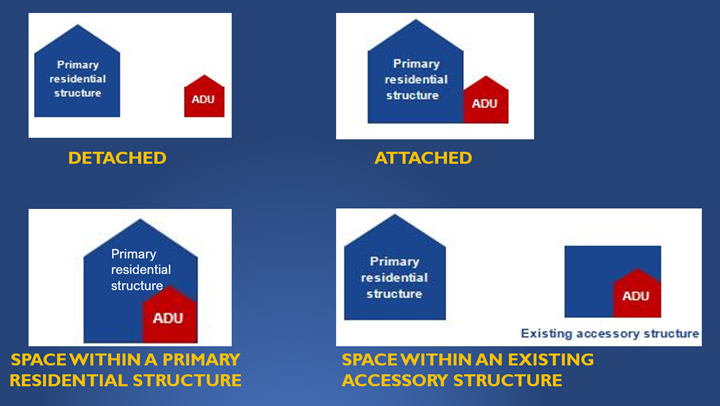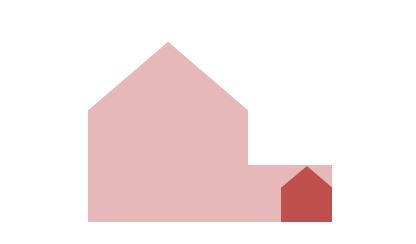Accessory Dwelling Unit Permits
CHANGES TO ADU REQUIREMENTS AND PERMITTING PROCESS!; AND NEW ADU ORDINANCE!
From 2018 through 2022, the state legislature has updated regulations for Accessory Dwelling Units (ADUs) and Junior Accessory Dwelling Units (JADUs) annually, with the intended purpose of easing local zoning controls, reducing associated development fees, and streamlining the permit process. The updated legislation expressly limits a local agency’s ability to regulate ADUs and JADUs. In 2024, an urgency legislation (AB 477) reorganized the ADU and JADU laws into a new Government Code chapter. Current state law can be found on the State of California’s Legislative Information website for the following:
- Current State law regarding Accessory Dwelling Units can be found on the State of California’s Legislative Information website
California Gov Code Section 66310 on Assistive Tech in Elementary Education
(Gov. Code Section 66310 et. Seq). - Junior Accessory Dwelling Units – Gov. Code Section 66333 et seq, linked
Government Section 66333 Information
.
More information about the recent state-wide changes to Accessory Dwelling Units, including the State’s ADU Handbook (most recently updated in July 2022), can be found on the California
Department of Housing and Community Development’s (HCD) Accessory Dwelling Units
webpage.
On February 7, 2023, the County Board of Supervisors adopted amendments to Articles 2, 5, 7, 8, 11, and 19 of the Ventura County Non-Coastal Zoning Ordinance (NCZO), which amended existing regulations for ADUs, and added regulations for JADUs, consistent with the above-mentioned state regulations. This Ordinance clearly identifies the available permitting pathways for ADUs and JADUs, as well as requirements for parcels in non-coastal areas. The adopted amendments to the Non-Coastal Zoning Ordinance were effective on March 9, 2023.
The adopted ADU ordinance applicable to the non-coastal areas was submitted to HCD for its review, as required by state law. HCD requested certain revisions consistent with state law in late 2023. Based on discussion with HCD staff, the Planning Division is in the process of further amending Section 8107-1.7 of the NCZO. Information regarding this ordinance and its public hearings is available on the Accessory Dwelling Unit Ordinance Update webpage here.
Note: Planning Division staff will be updating ADU and JADU regulations consistent with state law requirements in the Coastal Zoning Ordinance soon. Until that time, all coastal ADU permit applications will be reviewed using both the County’s existing development standards pursuant to Coastal Zoning Ordinance Section 8175-5.1.1 (available here) and, where applicable, the State’s revised development standards to verify consistency with state law. Please check back this webpage for the anticipated timeframe regarding this project.
What is an ADU and JADU?
Accessory Dwelling Unit (ADU) – Accessory Dwelling Unit (ADU) – An ADU is an attached or a detached residential dwelling unit, or a unit within the existing space of a primary dwelling unit, which provides complete independent living facilities for one or more persons and is located on a lot with a proposed or existing primary dwelling. It shall include permanent provisions for living, sleeping, eating, cooking, and sanitation on the same lot as the proposed or existing single-family or multifamily dwelling. An accessory dwelling unit also includes the following: (a) An efficiency unit, as defined in section 17958.1 of the Health and Safety Code, and (b) A manufactured home, as defined in section 18007 of the Health and Safety Code.
ADUs may be developed in one of the four configurations:
Regulation for ADUs and JADUs
* Note: Zoning designations and their abbreviations used below refer to the following zones. See the Non-Coastal Zoning Ordinance for all other requirements regarding the zone:
Legend for Zoning Designations
- Single-Family Residential (R1)
- Two-Family Residential (R2)
- Residential (RES)
- Residential Planned Development (RPD)
- Single-Family Estate (RO)
- Residential Mixed Use (R/MU)
- Residential High Density (RHD)
- Rural Agricultural (RA)
- Rural Exclusive (RE)
- Commercial Planned Development within a Community Business District overlay zone (CPD/CBD)
- Agricultural Exclusive (AE)
- Open Space (OS)
- Timberland Preserve (TP)
A. ADUs and JADUs allowed with a Building Permit
The new state regulations allow for the development of an ADU or JADU to apply directly for a building permit for construction if it meets the criteria listed below. Parcels in non-coastal areas should refer to NCZO Sections 8107-1.7.4 and 8107-1.7.6 for ADUs and JADUs allowed with a Building Permit
ADUs Within Space of Single-Family Dwellings and Accessory Structures
- One ADU per lot within a portion of a proposed or existing single-family dwelling with exterior access or created by converting existing space of a residential accessory structure. Setbacks must comply with building and fire code, even if existing setbacks are legal non-conforming.
- One JADU is also allowed on the same lot provided the JADU complies with Government Code section 65852.22 and NCZO Section 8107-1.7.6.
Zones allowed*: R1, R2, RES, RPD, R/MU, RA, RE, RO, or CPD/CBD.
2. New Detached ADU with an Existing or Proposed Single-Family Dwelling
One detached new construction ADU is allowed on a lot with a proposed or existing single-family dwelling and may be combined with a JADU. The new detached ADU:
- Can have a maximum size of 850 square feet,
- Must have minimum 4-foot side and rear setbacks, and
- Must meet height requirements per state law requirements. See height section below
Zones allowed*: R1, R2, RES, RPD, R/MU, RA, RE, RO, or CPD/CBD.
3. ADUs in Existing Multifamily Dwelling Structures
ADUs are allowed to be created within portions of existing multifamily dwelling structures that are not used as livable space (e.g., garage, carports, storage, boiler rooms, etc.). On a lot with mixed uses, only the non-livable space in the residential areas can be utilized to create an ADU.
The maximum number of ADUs allowed shall be at least one ADU, or the number of ADUs equal to up to 25 percent of the existing multifamily dwelling units, whichever is greater. Property owner(s) may combine ADUs created from the conversion of existing space, with detached ADUs as described in Option 4 below.
Zones allowed*: R1, R2, RES, RPD, R/MU, RHD, RA, RE, RO, or CPD/CBD.
4. Detached ADUs on lots with Existing or Proposed Multifamily Dwelling
Up to two detached ADUs are allowed on lots with an existing or proposed multifamily dwelling, with:
- Minimum 4-foot side and rear setbacks
- Each detached ADU can have a maximum size of 1,200 square feet, and
- Must meet height requirements per state law requirements. See height section below
Property owner(s) may combine detached ADUs with ADUs created from the conversion of existing space, as described in Option 3 above.
Detached ADUs may be attached to each other, but must be detached from the existing or proposed multifamily dwelling and from other accessory structures on the lot.
Zones allowed*: R1, R2, RES, RPD, R/MU, RHD, RA, RE, RO, or CPD/CBD.
5. Junior Accessory Dwelling Units (JADUs)
One JADU is allowed per lot zoned single-family residential with a proposed or existing single-family dwelling, including attached garages, if:
- It is up to 500 square feet created within the walls of a proposed or existing single-family dwelling, with an efficiency kitchen and a separate entrance from the main entrance.
- JADUs are not allowed in multifamily dwellings and on lots with more than one detached single-family dwelling.
- The JADU can share sanitation facilities with the single-family residence or have separate sanitation facilities.
- No parking is required for a JADU when the JADU converts an existing attached garage; replacement parking for the primary residential structure is not required).
- The owner of the lot must reside in the single-family dwelling, and upon completion of construction of the JADU, the owner must occupy either the remaining portion of the single-family dwelling or the JADU.
Zones allowed*: R1, R2, RES, RPD, RA, RE, or RO
B. All other ADUs (allowed with a Zoning Clearance)
Proposed ADUs that do not meet the state criteria above are subject to review with a Zoning Clearance prior to application for a Building Permit. ADUs allowed with a Zoning Clearance in non-coastal areas must comply with Section 8107-1.7.5, which is available here. The following summarizes the allowances in this section.
- Required for parcels that don’t meet Building Permit ADU requirements in Section 8107-1.7.4;
- Permitted on zones which allow residential dwellings (Zones allowed*: R1, R2, RES, RPD, R/MU, RHD, RA, RE, RO, CPD/CBD, OS, AE, or TP);
- Lots must have an existing or proposed single-family or multifamily dwelling;
- Each lot can build one ADU;
- Allows for larger ADUs of up to 1,800 square feet, based on criteria;
- Must meet setback, parking, and height requirements in Section 8107-1.7.5;
- Includes a limited exception to development standards for ADUs (per state law) and
- Must meet Building Code and Fire Code requirements and other applicable zoning standards
C. Maximum Allowed Height for All Detached ADUs
- Maximum of 16 feet above grade on a lot with an existing or proposed single-family or multifamily dwelling or
- Maximum of 18 feet above grade on a lot with an existing or proposed multifamily dwelling with multiple stories or
- Maximum of 18 feet above grade if the lot has an existing or proposed single-family or multifamily dwelling, and is within one half-mile walking distance of a major transit stop or a high-quality transit corridor, as defined in Section 21155 of the Public Resources Code. An additional two feet in overall height is allowed to accommodate a roof pitch that is aligned with the roof pitch of the primary dwelling unit.
- Detached ADUs may exceed the allowable height limits in (a) through (c) above if the ADU is set back at least 20 feet from all property lines, but the ADU shall not exceed the maximum allowed building height of the primary dwelling unit on the lot, pursuant to Article 6 of the NCZO.
APPLY FOR AN ADU/JADU PERMIT:
If your ADU/JADU meets the standards in Section A , you do not need a permit from Planning. Submit for a Building Permit.
See the following links for applicable permit applications and supporting information.
- Ministerial Zoning Clearance – For ADUs allowed with a Zoning Clearance per NCZO Section 8107-1.7.5
- Estimated Rental Amount for ADUs – In order to address
Program HE-Z in the 2021-2029 Housing Element
adopted by the Board of Supervisors and certified by HCD. Planning Division staff is required to collect information regarding the use and affordability of ADUs and report it to the state on an annual basis. Therefore, all property owners will be required to provide an estimated rental amount for the proposed ADU at the time of the permit. - Deed Restrictions for ADUs and JADUs – Pursuant to state law and the Non-Coastal Zoning Ordinance (NCZO), upon approval of an ADU and JADU, a deed restriction or an affidavit is required to be recorded in the County Recorder’s Office at the expense of the property owner. Please note that the deed restrictions require two exhibits that the property owner must provide: Exhibit A – the legal description of the property, and Exhibit B – a copy of the approved ADU/JADU permit and approved plans.
- Non-Coastal Zones only, please complete and print the following applicable forms:
- Coastal Zones only, please complete and print the following applicable forms:
Informational Materials
Planning staff is currently in the process of preparing public information materials and updating permitting documents to reflect the new requirements, which will be posted on this page as well as other relevant Planning Division web pages
1. ADU/JADU Homeowners Guidebook (coming soon)
Staff is in the process of creating a guidebook which will contain all permitting and development requirements for ADUs and JADUs listed above, which will assist the property owner or developer in navigating through the various options available for their parcel. The guidebook will also contain benefits of building an ADU, determining the permitting pathway for a certain option, Frequently Asked Questions and other helpful resources. Please check back for updates.
2. Standardized Plans available for Detached ADUs
The County has prepared and is making available to the public a complete set of standardized plans that can be utilized to construct detached ADUs. These plans have already been reviewed and pre-approved by the Building and Safety Division. Utilizing these pre-approved plans will save time and money during the permitting process.
These standardized plans are free of charge, and they provide County residents with a cost-effective option to build an ADU on their property using this standardized design in an affordable manner without the cost or time typically needed for a new design. Generally, they reduce the need to hire an architect if the plans are used exactly as approved. See more info regarding the three available layouts for one-, two- and three-bedroom units here.
Questions?
If you have further questions or need assistance with applying for an ADU, please contact the County of Ventura’s Planning Division at plan.counter@ventura.org or by calling 805-654-2488.
Contact Us
County of Ventura’s Planning Division
805-654-2488
plan.counter@ventura.org







